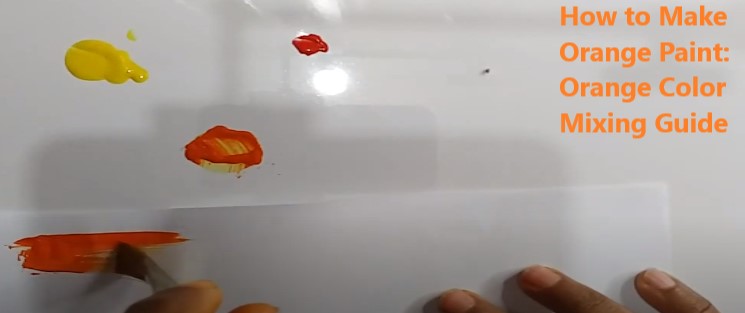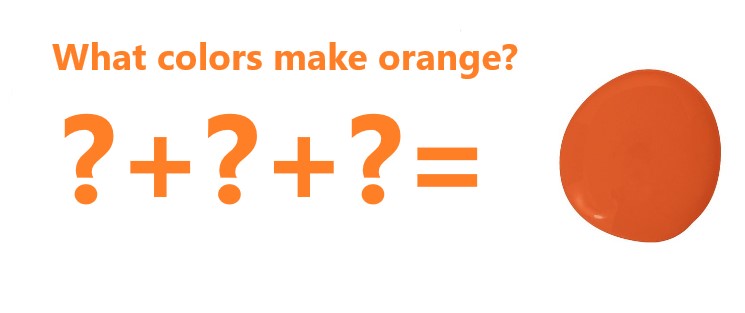So, you have run out of orange paint, right? Well, trust us, you are not the only one. We even ran out of certain colors while painting a masterpiece.
And at those moments, waiting for the new orange paint to ship to our doorstep is not an option.

However, you won’t even have to head out to get one by yourself either. Do you know why? Because we are going to teach you how to make orange paint.
And the best part is that you will be using the paints already available in your arsenal. So, let us not waste any more of your precious time and get into the guide.
Contents
What Colors Make Orange Paint?
Before we get into the making orange paint step-by-step process, we would like to give you an idea regarding what colors actually make orange paint.
As you might know by now, orange is a secondary color. That means it is obtained by mixing the primary colors.

If someone asks you what colors make orange paint, your answer should be yellow and red. Remember, yellow and red both are primary colors. And the secondary color, orange, that you will get after mixing these two primary colors will have a vivid shade.
However, the saturation of the color will play an essential role in this case. You cannot just simply mix a dull shade of red with a dull shade of yellow.
It will not offer that much of a better orange color. However, there are scenarios where you might need to use the pale shade of the orange color.
Nonetheless, we will go through the basics of making different shades of orange in the next segment. So, keep on reading.
How to Make Orange Paint: Different Shades of Orange Color
Would you believe us if we told you that you could make every shade of the orange color in four simple steps? Yes! That is certainly possible! Do not believe us? Go through these steps:
Step 1: Gather Five Different Shades of Yellow and Four Different Shades of Red
First and foremost, you need to pick five different shades of yellow. The ones that we are going to experiment on in this guide are yellow ochre, cadmium lemon, cadmium yellow, cadmium yellow light, and cadmium yellow deep.
Then, get the tubes of alizarin crimson, vermilion hue, permanent rose, and cadmium red. Yes, we understand that you might not have all of the shades of yellow and red available in your inventory.
But you have to realize that this is a general guide, which means you can work with any of the shades that you might have among the ones that we have mentioned.
Step 2: Drop a Bit of the Yellow and Red Colors on Your Palette
Once you have gathered all of the shades we mentioned above or the available ones, you need to drop a small amount of them in the palette.
Instead of randomly pouring the colors, it will be better to keep the yellow on the row side and red on the column side.
Also, remember that you need to keep each of the shades separated. You also need to keep a good amount of space left for the mixing to happen. Once you have poured each of the shades, move along to the next step.
Step 3: Mix the Colors
After pouring the colors on the palette, you might have already predicted the outcome of the mix.
For us, we have expected that cadmium red and cadmium yellow will offer the most vibrant version of the orange. On the other hand, the alizarin crimson and yellow ochre would provide a dull version of orange.
Do you know why? Well, it is easy to guess the outcomes if you consider the color temperature of the paints. The cooler the temperature or tone, the vivid the results are going to be. And the warmer the tone, the duller the results will be.
That being said, when you are mixing the colors, try to balance both of them. But do factor in the fact that some of the colors are stronger than the other paints.
For example, cadmium lemon is pretty weak compared to the shades of red that we have used. So, we would need to use more amount of that.
Work on each color by taking some yellow from the row and some red from the column side and filling up each of the cells.
We would recommend using a palette knife because it will ensure that the mixing is done correctly. However, you can use a brush too.
On that note, when you are using a single brush, make sure that you are rinsing the brush and drying it up before working with the other cells.
Once you are done filling each of the cells by taking a bit of yellow from the rows and the red from the column, you should end up with a matrix of different shades of orange color.
Step 4: Analyze the Blends
Now that you are done mixing up the colors, it will be time to analyze the results. From the shades that we have picked, the results came out as expected.
The deep mix of cadmium yellow and cadmium red offered us the brightest and most vivid orange, while the alizarin crimson and yellow ochre provided the dullest.
The rest were in between the range of bright and dull. That being said, if you did not use as many shades of orange and yellow as ours, your results would not be as broad as ours.
You might end up with six different shades of orange if you have used three shades of yellow and two shades of red.
That being said, from the mixture that you have just made, select the one that will go well with the masterpiece with which you are working.
And now that you have a general idea of which shade of yellow and red will offer which shade of orange, you can mix them in a large quantity.
Tweaks and Adjustments
The shade of orange that you might have got from the mixture of yellow and red might not be up to your satisfaction. Well, in that case, you need to make some further adjustments.
Read Next:
How to Make Darker Orange Paint
Usually, the dull mixture of orange paint is going to provide the darkest shade of orange. So, if you have used any other shade of red other than alizarin crimson, you might not end up with the darkest form of orange.
In this case, you would need to increase the amount of red. Mix a brush-worth of red on the mixture and analyze the outcomes. If the shade is not up to the mark, add more red paint.
How to Make Brighter Orange Paint
If you have ended up with a dull version of the orange paint, you did not use the vibrant version of red and yellow in the mixture.
In that case, if you do not have cadmium red and yellow in your arsenal, we would recommend increasing the amount of yellow in your mix. That should offer you a bright version of orange.
Nonetheless, if you want the most vivid version of orange, deeply mix cadmium yellow and cadmium lemon together first. Then finish the blend up by adding cadmium red.
How to Make Burnt Orange Paint
Burnt shades of color do add a different texture and depth to your paintings. However, to get the burn version of orange paint, you need to work with multiple shades of yellow and red. Also, you need an additional color, which is burnt sienna.
Get your palette ready and start with the pale cadmium of yellow. Add a little amount of lemon yellow to the mixture. Use the knife to mix these two yellows properly.
Then drop in cadmium red and a permanent rose shade of red. Mix the whole thing together properly.
At this point, you should end up with a shade of orange that will have a burnt shade to it. But we artists want to get the most out of the paints we use, correct?
Well, to deepen up the color and add a little bit of brown edge to the color, you need to add a touch of burnt sienna.
Making Orange Color Paint without Yellow
If you have run out of orange, you could mix red and blue to get a shade of orange. However, this shade will not have that much vibrancy or depth to it.
Final Words
Hopefully, after going through our guide on making DIY orange paint, you will not panic anymore once you run out of orange color.
Just work with the yellow and red that you have available and tweak them further to get the desired shade.
